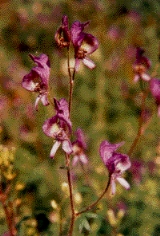
Aconitum noveboracense
Encyclopedia
Aconitum noveboracense, also known as Northern Blue Monkshood or Northern Wild Monkshood, is a flowering plant
belonging to the buttercup family (Ranunculaceae
). Members of its genus (Aconitum
) are also known as wolfsbane.
The United States Fish and Wildlife Service
government lists it as a threatened species. It grows in rare portions of New York State and in portions of the Driftless Area.
Northern monkshood is noted for its very distinctive, blue hood-shaped flowers. The flowers are about 1 inch in length, and a single stem may have many flowers. Stems range from about 1 to 4 feet in length. The leaves are broad with coarse, toothed lobes.
Northern monkshood is a perennial and reproduces from both seed and small tubers. The flowers bloom between June and September and are pollinated when bumblebees pry open the blossom to collect nectar and pollen.
Plant
Plants are living organisms belonging to the kingdom Plantae. Precise definitions of the kingdom vary, but as the term is used here, plants include familiar organisms such as trees, flowers, herbs, bushes, grasses, vines, ferns, mosses, and green algae. The group is also called green plants or...
belonging to the buttercup family (Ranunculaceae
Ranunculaceae
Ranunculaceae are a family of about 1700 species of flowering plants in about 60 genera, distributed worldwide....
). Members of its genus (Aconitum
Aconitum
Aconitum , known as aconite, monkshood, wolfsbane, leopard's bane, women's bane, Devil's helmet or blue rocket, is a genus of over 250 species of flowering plants belonging to the buttercup family .-Overview:These herbaceous perennial plants are chiefly natives of the mountainous parts of the...
) are also known as wolfsbane.
The United States Fish and Wildlife Service
United States Fish and Wildlife Service
The United States Fish and Wildlife Service is a federal government agency within the United States Department of the Interior dedicated to the management of fish, wildlife, and natural habitats...
government lists it as a threatened species. It grows in rare portions of New York State and in portions of the Driftless Area.
Northern monkshood is noted for its very distinctive, blue hood-shaped flowers. The flowers are about 1 inch in length, and a single stem may have many flowers. Stems range from about 1 to 4 feet in length. The leaves are broad with coarse, toothed lobes.
- Only found in Iowa, Wisconsin, Ohio, and New York.
- Typically found on shaded to partially shaded cliffs, algific talus slopes, or on cool, streamside sites. These areas have cool soil conditions, cold air drainage, or cold groundwater flowage. On algific talus slopes, these conditions are caused by the outflow of cool air and water from ice contained in underground fissures. These fissures are connected to sinkholes and are a conduit for the air flows.
Northern monkshood is a perennial and reproduces from both seed and small tubers. The flowers bloom between June and September and are pollinated when bumblebees pry open the blossom to collect nectar and pollen.
Causes of Threatened Status
- Habitat Loss or Degradation - Threats to northern monkshood include contamination and filling of sinkholes, grazing and trampling by livestock, human foot traffic, logging, maintenance of highways and power lines, misapplication of pesticides, quarrying, and road building.
- Collection - Some populations have been adversely affected by scientific collection.
Protection
- Listing - Northern monkshood was added to the U.S. List of Endangered and Threatened Wildlife and Plants in 1978.
- Recovery Plan - The U.S. Fish and Wildlife Service has developed a recovery plan that describes actions needed to help the plant survive.
- Research - Many northern monkshood populations are being monitored to determine long-term population trends. Genetic studies are being conducted so population differences can be better understood.
- Habitat Protection - A variety of government and private conservation agencies are all working to preserve the northern monkshood and its habitat. Voluntary protection agreements have also been made with some private landowners.

